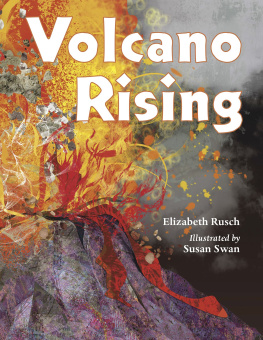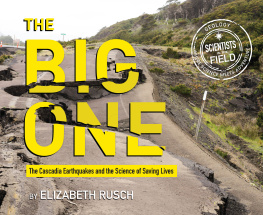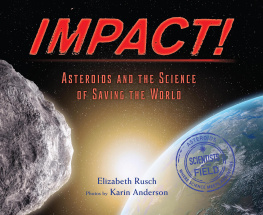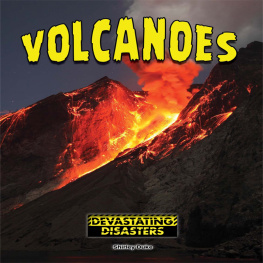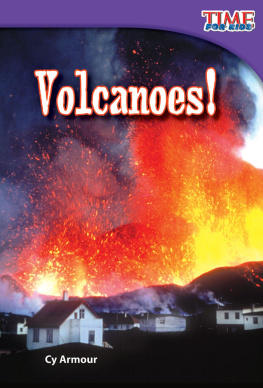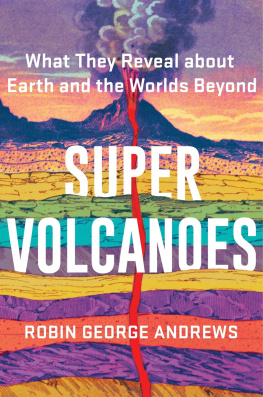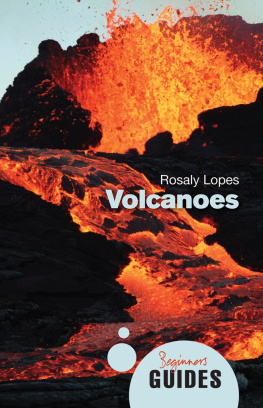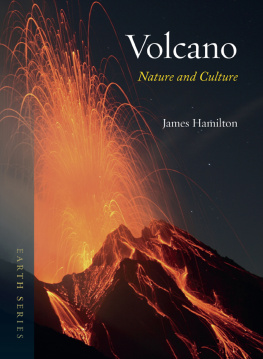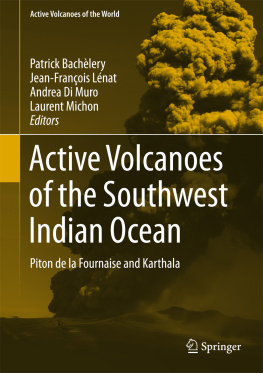
Elizabeth Rusch
Illustrated by Susan Swan

KA-BOOM! Most people think volcanoes
are either sound asleep or blowing their
tops off in fiery, ash-spewing catastrophes.

But volcanoes are not just destructive.
Much more often, volcanoes are creative.
They grow taller and wider. They form
majestic mountains. And they build new
islands where there were none before.


Both creative and destructive eruptions
start with gooey melted rock called magma.
Magma from deep in the earth rises up a
gigantic strawlike tube to a vent, or opening.
If magma makes it to the earths surface, its
called lava. A burst of lava is an eruption.
Magma is made up of gases as well as melted and partially
melted rock. As it rises and fills huge underground
chambers, pressure builds... and builds... and builds...
until the magma is forced up and out a volcanos vent.
Erupted magma can spurt out and flow down a volcano
like red-hot syrup. This fluid lava cools to form either spiky
chunks called aa
(ah-aah) or smooth, ropy surfaces called
pa hoehoe
(paah-hoh-eh-hoh-eh).
Magma can also burst out in solid chunks called tephra
(TEH-frah). Tephra can be tiny bits (ash), lightweight
gas-filled pieces (pumice), or solid rocks and boulders
(lava bombs).
But what determines whether lava erupts peacefully
or dangerously?
aa

tephra
lava
vent
magma chamber

POW! Gases blast lava out in an
explosive eruption.

HISSSSS! Gases and lava slowly seep out
in a creative eruption.
Gas determines whether an eruption creates or destroys.
Rising gas pushes lava out of a volcano. In destructive
eruptions, gases get trapped inside thick magma or are
blocked by plugs in the vents. Pressure builds until lava, ash,
and gases explode all at once, like soda from a shaken can.
In creative eruptions, vents are open and gases escape
slowly, like when you carefully unscrew a soda bottle. Lava
bubbles and sprays like water from a hose or oozes out like
toothpaste from a tube. Layer upon layer of lava piles up,
forming lava domes. Over time, peaceful eruptions can
build mountains.
Creative eruptions occur three times more often than
violent ones. They happen all over the world in all kinds of
different places.

North Sister
Middle Sister

A creative eruption can start with the
ground swelling a tiny bit each year.
Magma gathering underground
creates a bulge that may one day
make a new mountain.
In the Cascade Range in central Oregon, three composite
volcanoes massive cones made from layers of both lava
and ash sit in a tight cluster, as if theyre having a tea
party. Theyre called the Three Sisters: North, Middle,
and South Sister.
But wait, whats this? A large area next to South Sister
rose four inches (ten centimeters) between 1996 and 2000
and continues to rise. This uplift is caused by magma
pooling a few miles under the surface. Scientists think a
new volcano West Sister may join the party sometime,
giving us yet another spectacular mountain to explore.
South Sister

Sometimes creation happens more quickly.
Volcanoes can appear out of nowhere! One
day the ground cracks and ash spurts out,
forming a new volcano.

In 1943, as a farmer plowed his cornfield in Paricutn
(pah-ree-koo-TEEN), Mexico, ash exploded from a crack in
the ground and rained down, creating a steep cinder cone.
In a day the cone reached feet (50 meters) high. In a
week it stood feet (150 meters ) tall. Ash slowly buried
the farm and nearby villages. But the family and villagers
moved to land close by and began farming the rich,
ash-fertilized fields.
After a year Paricutns cone was more than 1,000 feet
(330 meters) tall. After nine years the cinder-cone volcano
stood more than 1,300 feet (424 meters).
Paricutn is considered one of the wonders of the world.
It created a mountain, fertilized fields, and gave scientists
the chance to study the fast growth of a new volcano.
Paricutn
(day one)

Volcanoes even make mountains underwater.
If these submarine volcanoes grow high
enough, their tips form new islands.

Three-quarters of volcanic activity takes place deep in the

